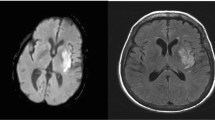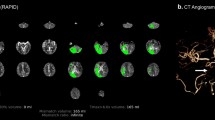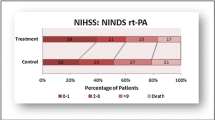Opinion statement
Stroke carries a severe toll in terms of loss of life and disability for patients and their families. Until 10 years ago, physicians, and in particular neurologists, had a conservative, nonaggresive approach to this devastating disease. The advent of thrombolytic therapy not only proved that acute ischemic stroke is treatable, but also that early reperfusion can dramatically change the outcome of acute stroke patients. As a result of these trials, intravenous (IV) tissue plasminogen activator (t-PA) has been approved for treatment of acute ischemic stroke within 3 hours after symptom onset in the United States, Canada, Australia, and the European Union. The near future is extremely promising. Imaging modalities, such as diffusion- and perfusion-weighted images, as well as CT perfusion and CT angiography, to better select patients for treatment are now routinely performed in most academic medical centers. Novel IV and intra-arterial (IA) agents have been developed and tested. Emerging therapies will soon be available to increase the therapeutic windows for thrombolysis both by better screening patients using MRI or CT and by new IV and IA treatments. Several multicenter controlled trials in both imaging-guided decisions and therapeutic agents are either completed or being performed. We review data on advancement in imaging and treatment of acute ischemic stroke, in particular focusing on pharmacologic and mechanical IA thrombolysis.
Similar content being viewed by others
References and Recommended Reading
Heart Disease and Stroke Statistics--2005 Update. http://www.americanheart.org/presenter.jhtml?identifier= 3000090. Accessed October 4, 2005.
Baird AE, Warach S: Magnetic resonance imaging of acute stroke. J Cereb Blood Flow Metab 1998, 18:583–609.
Kidwell CS, Alger JR, Saver JL: Beyond mismatch: evolving paradigms in imaging the ischemic penumbra with multimodal MRI. Stroke 2003, 34:2729–2735. A comprehensive and well-written review.
Sunshine JL, Tarr RW, Lanzieri CF, et al.: Hyperacute stroke: ultrafast MR imaging to triage patients before therapy. Radiology 1999, 212:325–332.
Shih LC, Saver JL, Alger JR, et al.: Perfusion-weighted magnetic resonance imaging thresholds identifying core, irreversibly infarcted tissue. Stroke 2003, 34:1425–1430.
Schellinger PD, Fiebach JB, Jansen O, et al.: Stroke magnetic resonance imaging within 6 hours after onset of hyperacute cerebral ischemia. Ann Neurol 2001, 49:460–469.
Linfante I, Llinas RH, Caplan LR, et al.: MRI features of intracerebral hemorrhage within 2 hours from symptom onset. Stroke 1999, 30:2263–2267.
Linfante I: Can MRI reliably detect hyperacute intracerebral hemorrhage? Ask the medical student. Stroke 2004, 35:506–507.
Le Bihan D, Breton E, Lallemand D, et al.: MR imaging of intravoxel incoherent motions: application to diffusion and perfusion in neurologic disorders. Radiology 1986, 161:401–407.
Warach S, Chien D, Li W, et al.: Fast magnetic resonance diffusion-weighted imaging of acute human stroke. Neurology 1992, 42:1717–1723.
Edelman RR, Johnson K, Buxton R, et al.: MR of hemorrhage: a new approach. Am J Neuroradiol 1986, 7:751–756.
Fiebach JB, Schellinger PD, Gass A, et al.: Stroke magnetic resonance imaging is accurate in hyperacute intracerebral hemorrhage: a multicenter study on the validity of stroke imaging. Stroke 2004, 35:502–506.
Kidwell CS, Chalela JA, Saver JL, et al.: Comparison of MRI and CT for detection of acute intracerebral hemorrhage. JAMA 2004, 292:1823–1830. A well-designed and well-conducted study.
Sims JR, Rordorf G, Smith EE, et al.: Arterial occlusion revealed by CT angiography predicts NIH stroke score and acute outcomes after IV tPA treatment. Am J Neuroradiol 2005, 26:246–251.
Ezzeddine MA, Lev MH, McDonald CT, et al.: CT angiography with whole brain perfused blood volume imaging: added clinical value in the assessment of acute stroke. Stroke 2002, 33:959–966.
Eastwood JD, Lev MH, Wintermark M, et al.: Correlation of early dynamic CT perfusion imaging with whole-brain MR diffusion and perfusion imaging in acute hemispheric stroke. Am J Neuroradiol 2003, 24:1869–1875.
Alexandrov AV, Molina CA, Grotta JC, et al.: CLOTBUST Investigators: Ultrasound-enhanced systemic thrombolysis for acute ischemic stroke. N Engl J Med 2004, 351:2170–2178.
Tissue plasminogen activator for acute ischemic stroke. The National Institute of Neurological Disorders and Stroke rt-PA Stroke Study Group. N Engl J Med 1995, 333:1581–1587.
Frankel MR, Morgenstern LB, Kwiatkowski T, et al.: Predicting prognosis after stroke: a placebo group analysis from the National Institute of Neurological Disorders and Stroke rt-PA Stroke Trial. Neurology 2000, 55:952–959.
Reed SD, Cramer SC, Blough DK, et al.: Treatment with tissue plasminogen activator and inpatient mortality rates for patients with ischemic stroke treated in community hospitals. Stroke 2001, 32:1832–1840.
Johnston SC, Fung LH, Gillum LA, et al.: Utilization of intravenous tissue-type plasminogen activator for ischemic stroke at academic medical centers: the influence of ethnicity. Stroke 2001, 32:1061–1068.
Rubiera M, Alvarez-Sabin J, Ribo M, et al.: Predictors of early arterial reocclusion after tissue plasminogen activator-induced recanalization in acute ischemic stroke. Stroke 2005, 36:1452–1456.
Linfante I, Llinas RH, Selim M, et al.: Clinical and vascular outcome in ICA versus MCA occlusions after IV tPA. Stroke 2002, 33:2066–2071.
Gonner F, Remonda L, Mattle H, et al.: Local intraarterial thrombolysis in acute ischemic stroke. Stroke 1998, 29:1894–1900.
Qureshi AI: Endovascular treatment of cerebrovascular diseases and intracranial neoplasms. Lancet 2004, 363:804–813.
Molina CA, Saver JL: Extending reperfusion therapy for acute ischemic stroke: emerging pharmacological, mechanical, and imaging strategies. Stroke 2005, 36:2311–2320.
Qureshi AI, Siddiqui AM, Suri MF, et al.: Aggressive mechanical clot disruption and low-dose intra-arterial third-generation thrombolytic agent for ischemic stroke: a prospective study. Neurosurgery 2002, 51:1319–1327.
Qureshi AI, Ali Z, Suri MF, et al.: Intra-arterial thirdgeneration recombinant tissue plasminogen activator (reteplase) for acute ischemic stroke. Neurosurgery 2001, 49:41–48.
Deshmukh VR, Fiorella DJ, Albuquerque FC, et al.: Intra-arterial thrombolysis for acute ischemic stroke: preliminary experience with platelet glycoprotein IIb/ IIIa inhibitors as adjunctive therapy. Neurosurgery 2005, 56:46–54.
Furlan AJ, Higashida RT, Wechsler L, et al.: Intra-arterial prourokinase for acute ischemic stroke. The PROACT II study: a randomized controlled trial. Prolyse in Acute Cerebral Thromboembolism. JAMA 1999, 282:2003–2011.
Lewandowski CA, Frankel M, Tomsick TA, et al.: Combined intravenous and intra-arterial r-TPA versus intra-arterial therapy of acute ischemic stroke: Emergency Management of Stroke (EMS) Bridging Trial. Stroke 1999, 30:2598–2605.
IMS Study Investigators: Combined intravenous and intra-arterial recanalization for acute ischemic stroke: the Interventional Management of Stroke Study. Stroke 2004, 35:904–911. A well-designed trial.
Smith WS, Sung G, Starkman S, et al.: MERCI Trial Investigators: Safety and efficacy of mechanical embolectomy in acute ischemic stroke: results of the MERCI trial. Stroke 2005, 36:1432–1438.
Berlis A, Lutsep H, Barnwell S, et al.: Mechanical thrombolysis in acute ischemic stroke with endovascular photoacoustic recanalization. Stroke 2004, 35:1112–1116.
Fisher M, Albers GW, Donnan GA, et al.: Stroke Therapy Academic Industry Roundtable IV. Enhancing the development and approval of acute stroke therapies: Stroke Therapy Academic Industry roundtable. Stroke 2005, 36:1808–1813.
Author information
Authors and Affiliations
Rights and permissions
About this article
Cite this article
Linfante, I., Akkawi, N.M. Advances in treatment of acute ischemic stroke. Curr Treat Options Neurol 8, 159–165 (2006). https://doi.org/10.1007/s11940-006-0006-x
Issue Date:
DOI: https://doi.org/10.1007/s11940-006-0006-x




